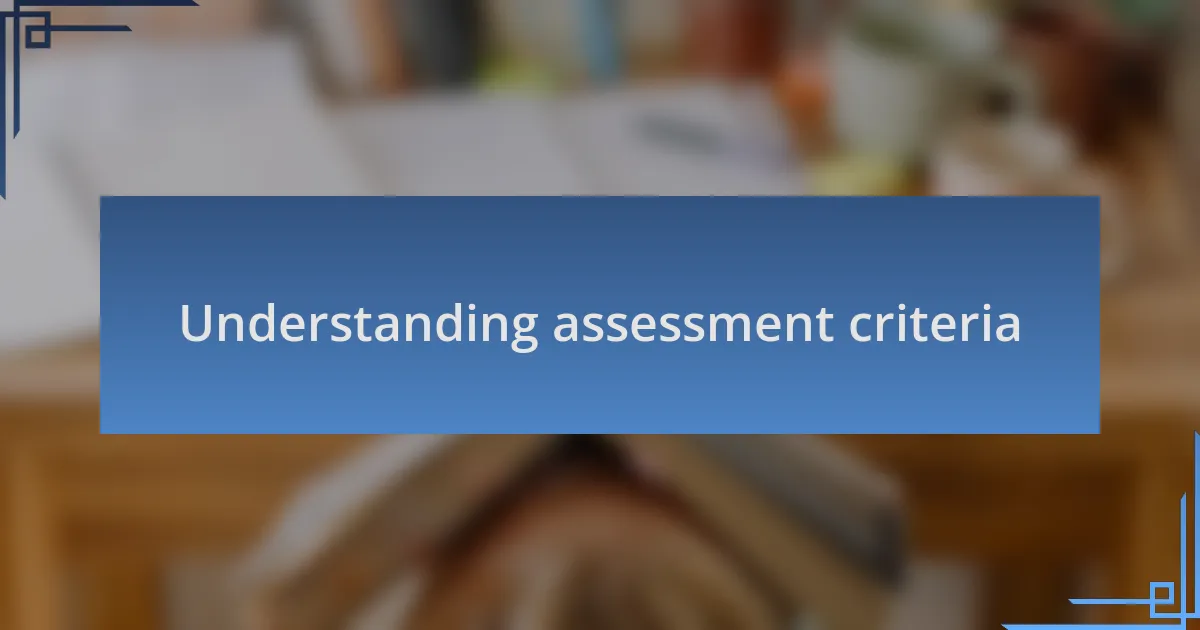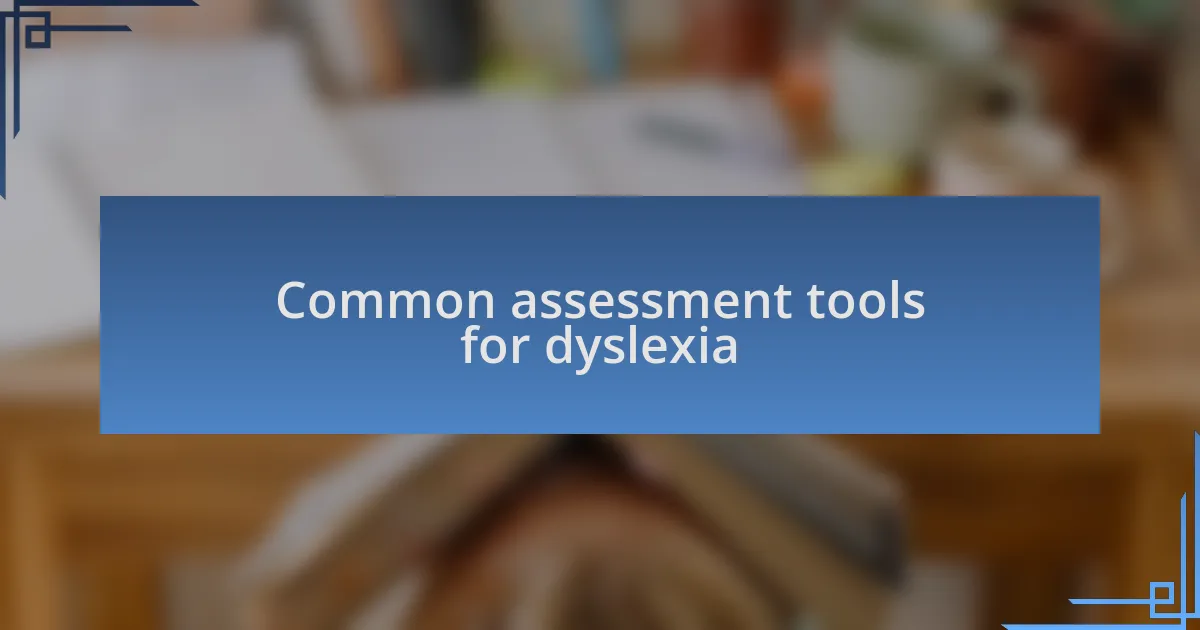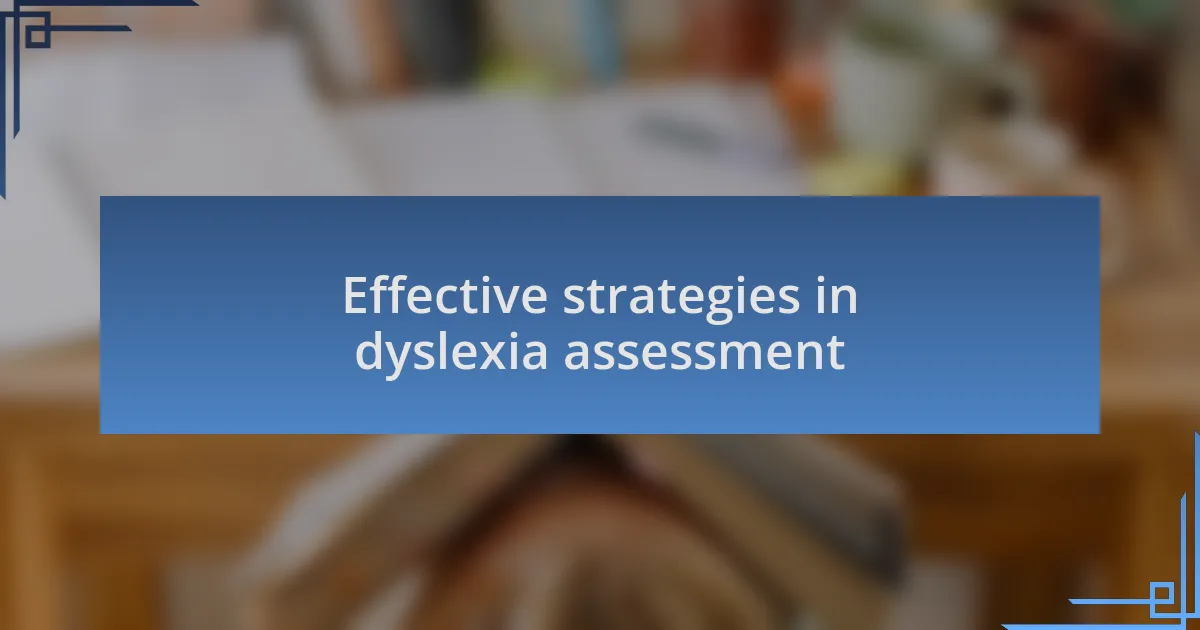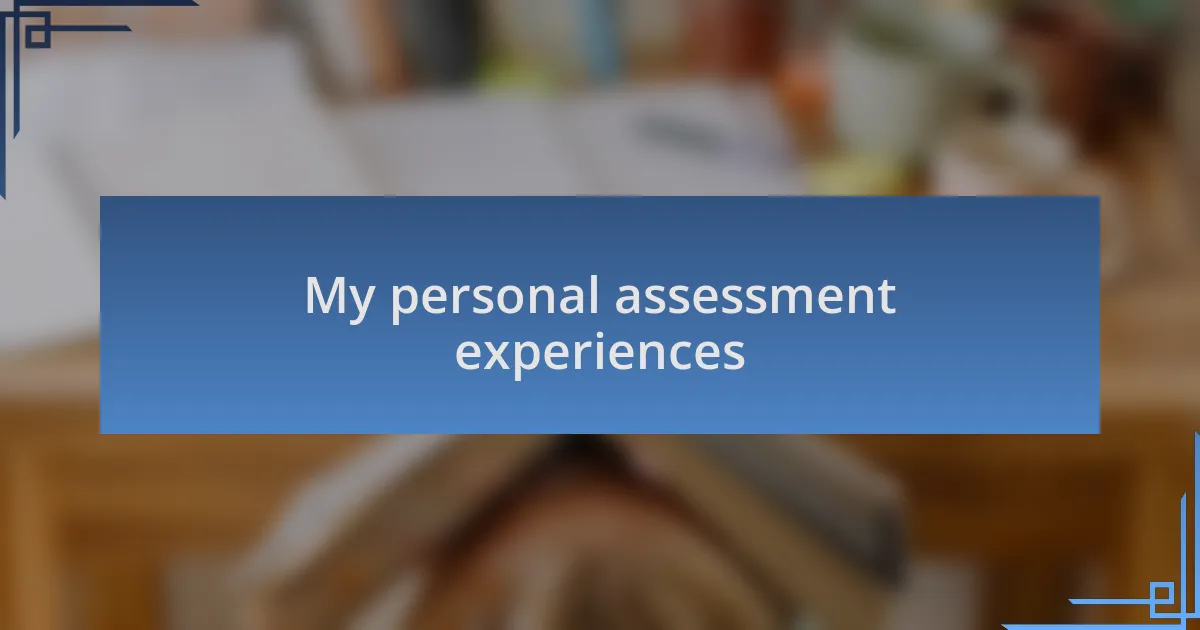Key takeaways:
- Understanding assessment criteria is crucial for students with dyslexia, as it aids in recognizing their progress and personal growth.
- Dynamic and collaborative assessment strategies enhance understanding by integrating multiple perspectives and focusing on students’ potential.
- Utilizing diverse and creative assessment methods, such as art projects and technology, can effectively reveal students’ knowledge and retain their engagement.
- Incorporating self-reflection and self-assessment helps students take ownership of their learning and fosters deeper motivation.

Understanding assessment criteria
Understanding assessment criteria is essential for effectively measuring progress and identifying strengths in individuals with dyslexia. I remember a student who wasn’t sure how their reading skills were assessed; they felt lost in the process. It struck me how critical it is that learners not only know what’s expected of them but also understand how these criteria relate to their personal growth.
When I first dove into dyslexia assessment, I experienced a blend of confusion and hope. Questions like, “Am I meeting the standards?” often flooded my mind. This feeling of uncertainty is common, and it’s vital to clarify what each aspect of the assessment criteria means. By breaking them down into digestible parts, learners can grasp how each criterion highlights their unique abilities rather than just their challenges.
It’s also important to recognize that assessment criteria should not merely focus on deficits; they need to celebrate achievements as well. I once worked with a student who improved in comprehension but struggled with spelling. By acknowledging their comprehension success while also discussing strategies for spelling, we created a balanced approach to their assessment. How can we ensure that assessments reflect the whole picture of a learner’s abilities? This is a crucial question we must continuously ask ourselves in the field of dyslexia training.

Common assessment tools for dyslexia
When it comes to assessing dyslexia, one of the common tools I often encounter is the Woodcock-Johnson Tests of Achievement. This tool provides a comprehensive evaluation of academic skills, helping pinpoint areas where a learner excels and where they may need additional support. I remember using these assessments with a young student who was brilliant in math but struggled with reading. Seeing that data helped us create a tailored plan that leveraged their strengths, which was incredibly rewarding.
Another frequently used tool is the Dyslexia Screening Test, designed specifically for identifying dyslexia early on. I recall a particular case where the screening revealed potential signs of dyslexia in a student who had been overlooked in previous assessments. The realization was bittersweet; it opened up paths for intervention that could prevent further academic struggles. How often do we miss early signs because we rely on a generalized approach?
In addition to formal assessments, I’ve found informal tools like portfolio assessments to be invaluable. This involves collecting a body of work over time, showcasing a student’s progress and challenges. I vividly remember sitting with a student, rifling through their portfolio, and celebrating moments of real growth—each piece telling its own story of perseverance. Isn’t it fascinating how a collection of their work can paint such a vivid picture of their journey? These tools not only reveal academic abilities but also foster a sense of pride and ownership in their learning process.

Effective strategies in dyslexia assessment
When I think about effective strategies in dyslexia assessment, one approach that stands out to me is the use of dynamic assessment. This method measures a student’s potential for learning rather than just their current abilities. For example, I once employed this strategy with a student who initially struggled to grasp phonics. By integrating guided practice sessions, we discovered not only their capacity to improve but also boosted their confidence significantly. Isn’t it incredible how focusing on potential can shift a learner’s mindset?
Another strategy I’ve found worthwhile is collaborative assessment. Engaging not just with the student, but also with their parents and teachers creates a fuller picture of the individual’s strengths and challenges. I remember sitting around a table with a family, discussing their child’s unique traits. Their insights provided perspectives I hadn’t considered, which ultimately enriched our assessment process. Have you ever noticed how different viewpoints can illuminate aspects of learning that may otherwise stay hidden?
Lastly, incorporating student self-assessment has proven fruitful in my experience. Allowing students to reflect on their own learning experiences empowers them to take ownership of their journey. I once guided a group of students through a self-reflection exercise, and their honest feedback was enlightening—seeing themselves through their own eyes revealed deeper insights than any formal assessment could offer. Isn’t it amazing how self-awareness can spark motivation and growth?

My personal assessment experiences
When I reflect on my personal experiences with assessment, one moment stands out vividly. I once worked with a student who was overly anxious about tests. We decided to turn the assessment into a casual conversation rather than a formal evaluation. Watching their face relax while discussing their thoughts and understanding was heartwarming. It made me realize how pressure can cloud potential; have you ever seen a student shine when the stress is lifted?
In another instance, I encountered a student who had distinct learning patterns that traditional assessments completely overlooked. By observing their interactions during group activities, I uncovered unique problem-solving skills that didn’t emerge in written tests. That experience taught me the invaluable lesson that assessment can occur in myriad contexts. How often do we miss out on a learner’s capabilities by focusing solely on standardized formats?
Moreover, I once facilitated a session where students worked in pairs to evaluate each other’s understanding of a topic. Witnessing their camaraderie while tackling challenges together was inspiring. They were not just assessing one another; they were building each other’s confidence. Isn’t it astonishing how peer assessment can foster a sense of community and collaboration in learning?

Lessons learned from my assessments
One significant lesson I learned from my assessments revolves around flexibility in evaluation methods. During one session, I introduced an art-based project to assess comprehension instead of a traditional test. I was amazed at how the students expressed their understanding through creative mediums; it illuminated their perspectives in ways words on paper never could. Have you ever thought about how much insight can come from allowing learners to showcase their knowledge creatively?
In another experience, I realized the importance of feedback in assessments. After giving a student a chance to discuss their answers verbally, their confidence surged. It was a revelation for me – I saw firsthand how providing immediate, constructive feedback not only clarifies misconceptions but also motivates learners to engage deeply with content. Isn’t it interesting how a simple conversation can transform a student’s outlook on learning?
One time, I used a game to evaluate students’ grasp of a complex topic. Their enthusiasm was infectious; they didn’t even realize they were being assessed. Observing how they thrived and collaborated in that setting reinforced my belief that assessments don’t have to be stressful or monotonous. Why can’t we make learning and evaluating a more joyful experience?

Recommendations for future assessments
When considering future assessments, one recommendation that stands out is the integration of technology to create interactive learning experiences. In my own training sessions, I experimented with online quizzes that provided immediate results. The instant feedback was powerful; not only did it keep students engaged, but it also allowed them to reflect on their mistakes promptly. How much more effective could assessments be if they utilized the tools that students are already familiar with?
Another important aspect is incorporating diverse assessment formats that cater to different learning styles. During a recent workshop, I included role-playing scenarios alongside traditional assessment methods. The energy in the room was palpable as students acted out concepts, deepening their understanding in a way that a written test simply wouldn’t capture. Have you noticed how engaging practical applications can be in illustrating complex ideas?
Lastly, I encourage a holistic approach to assessment that includes self-reflection. I introduced journals for students to track their learning journeys. This practice not only empowered them to take ownership of their progress but also provided invaluable insights into their emotional connection to the material. Isn’t it fascinating to think about how self-assessment can lead to deeper self-awareness and motivation in learners?